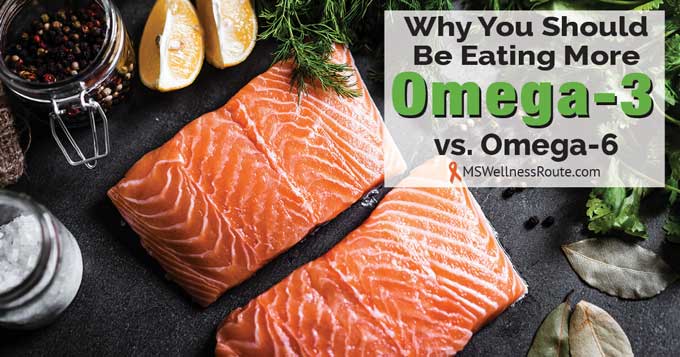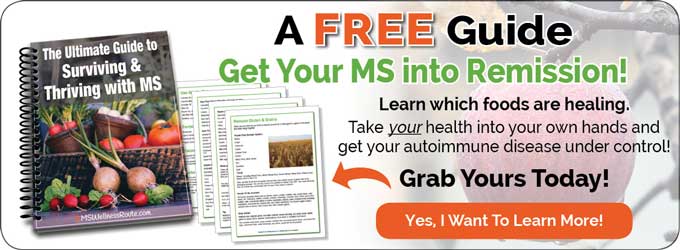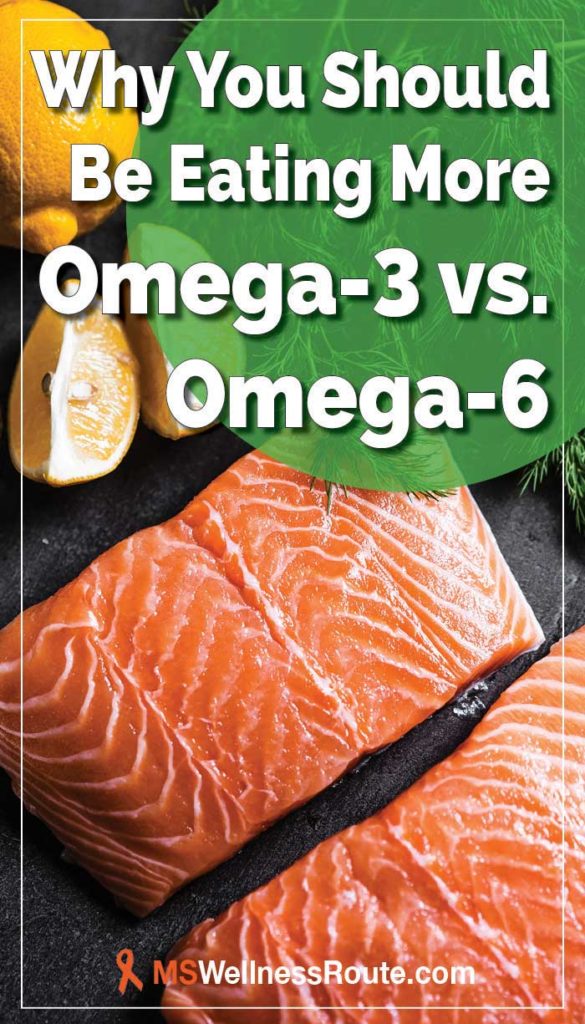Last Updated on January 30, 2025 by Cathy

Eating a nutrient-dense diet will help reduce chronic inflammation. But, have you paid attention to the ratio of omega-3 vs. omega-6 fatty acids that you’re eating?
Omega-6 and omega-3 are both important for our bodies. But too much omega-6 causes inflammation. Several decades ago people ate an equal amount. But then our diet shifted from a 1:1 omega-6 to omega-3 ratio to a 16:1 ratio, mainly from vegetable oils.
Essential fatty acids are important for the body’s cells to function properly. The only way to get omega-3 is through food or supplements. There are two types of omega-3s. ALA is in plant foods the other type is DHA and EPA is in animal foods like fatty fish.
Symptoms from too much omega-6:
- Circulation issues
- Constipation
- Dry skin
- Fatigue
- Heart issues
- Low energy
You may have already stopped eating vegetable oils. But, if you are eating conventionally raised meat your omega-6 increases. Conventionally raised animals feed on grains and soy to fatten them up. – Whatever they eat, you eat.
Grass-fed animals have an equal omega-6 to omega-3 ratio. Plus, grass-fed animals don’t have antibiotics or growth hormones. And they are free to roam in the pasture keeping them happy and less stressed.

Sources of omega-6:
- Cereals
- Eggs*
- Flaxseeds
- Nuts
- Poultry
- Pumpkin seeds
- Sesame seeds
- Vegetable oils (canola, corn, safflower, soy, etc.)
*It is best to avoid eggs while you are trying to heal. In the book The Wahls Protocol, Dr. Terry Wahls recommends people avoid eggs.
Vegetable oil consumption started to rise dramatically in the 1930s to an 8:1 ratio. Today some people eat as much as a 25:1 ratio. If you’re eating the standard American diet (SAD) you’re eating 10-25 times higher amounts of omega-6.
Benefits of Omega-3 vs. Omega-6

The ratio of omega-6 to omega-3 matters when it comes to your health. Too much omega-6 creates chronic inflammation that causes diseases such as multiple sclerosis.
Diseases caused by too much omega-6:
- Autoimmune diseases
- Cancer
- Heart disease
- Obesity
- Osteoporosis
- Stroke
- Type 2 diabetes
The more omega-3 you consume, the better – right? Well… if only it was that easy. The paleo diet is excellent for reducing inflammation. The diet recommends eating grass-fed meats, pasture-raised poultry, and wild-caught fish.
Following a paleo diet is a nutrient-dense diet. But many people fail to pay attention to their omega-6 to omega-3 ratio. Since grains aren’t allowed on a paleo diet many people turn to nut flours. Then they drink a glass of almond milk and a handful of nuts as a snack later in the day.
By the end of the day, they’ve consumed too many nuts and too much omega-6. Even though the paleo diet recommends increasing the amount of omega-3 a person eats. Too many people are still consuming too much omega-6.
To get to a ratio of 1:1 you need to lower your omega-6 and increase your omega-3. The only food source that’s rich in DHA and EPA is fatty fish like salmon. However, the pollution in the ocean gets stored in the fish’s fat cells which are then stored in our own cells.
For the benefits, it’s still safe to eat fish up to two times per week. Pregnant women should eat low-mercury fish, speak to your doctor first. However, it’s best to avoid larger fish such as king mackerel and tilefish.
Foods high in omega-3:
- Algae
- Chia seeds
- English walnuts
- Fatty fish (rainbow trout, salmon, sardines)
- Fish oil supplements
- Flaxseeds, fresh-ground
- Grass-fed butter
- Grass-fed meats
- Hemp seeds
Animal fats, lard, and tallow are the best to cook with for high-temperature cooking.
It’s important to eat both omega-3 and omega-6 fats. But it is important to pay attention to how much omega-6 you’re eating. Try to get as close to a 1:1 ratio as possible. Even a 4:1 is better than a 16:1.
Since it’s now known that inflammation is the cause of nearly all diseases, including MS. It’s hard to ignore the importance of eating more omega-3. Studies show that people who eat more fish have slower rates of cognitive decline.
The Best Omega-3 Supplements

If you don’t like eating fish make sure you are taking a good quality fish oil or omega-3 supplement. While plant-source omega-3 is beneficial, it’s the fatty fish that gives you the most benefits.
Look for supplements that contain DHA and EPA. I make a point to eat fish once or twice a week plus I take a good quality plant-based omega supplement that includes both EPA and DHA. Supplementing with omega-3 is a good way to build up your nutrients since your body doesn’t produce them.
Here are some steps you can start today:
- Avoid vegetable oils and products that have them in them. They are extremely harmful to your health so you should never eat them.
- Increase your omega-3s by eating more fatty fish and supplements.
- Eat healthy fats like coconut oil, olive oil, and organic grass-fed meats and dairy (if you eat dairy). Coconut oil has saturated fat so the American Heart Association recommends avoiding it. That’s because it raises “bad” cholesterol. But, coconut oil also raises “good” cholesterol levels. Instead of focusing on cholesterol, we should be focusing on inflammation. Inflammation is what causes heart disease.
- Keep moving, this is extremely important for people with MS. Moving, stretching, and exercises help with stiff muscles, a very common symptom of MS.
- Get a good night’s sleep. As you sleep your central nervous system is busy repairing itself. If you have insomnia try setting a bedtime route. Sleep in a dark and cooler room. Avoid electronics a few hours before bedtime. Use essential oils like Lavender or Sleep Tight.
- Reduce stress. It’s hard to avoid stress entirely but it’s how you manage the stress that makes a huge difference. Learn relaxation techniques like deep breathing, muscle relaxation, meditation, or listening to music.
There is a blood test you could get if you really want to know your numbers. But, to save money just look at what you’re eating. You already know if you’re eating enough fatty fish or not.
Tip the balance by consuming more omega-3-rich foods and supplements. Consume more oily fish, fish oil, leafy green vegetables, flaxseeds, chia seeds, and walnuts.

Free Wellness Library!
Subscribe for free and I’ll send you the password to my secret library filled with many printables for your wellness journey.
Want to remember this health tip? Pin it to your favorite Pinterest board!

Resources:
Wikipedia, Omega-6 fatty acid
US National Library of Medicine, The science behind dietary omega-3 fatty acids
US National Library of Medicine, Fish consumption and cognitive decline with age in a large community study





